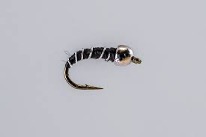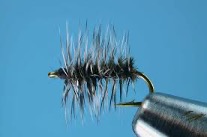By Don Fine

Our PVFF Beginner’s Fly Tying session for November is a continuance of our fly tying theme for this year, with patterns chosen to represent a different category of aquatic fish food and to introduce new tying materials and techniques. Through this year the flies which we have learned to tie represent various forms of mayflies, caddisflies, minnows, worms and terrestrials. Our November program focuses on another very prevalent category of insects, which fish feed on throughout the year – midges. With winter coming on in the next several months, fish (particularly trout) will turn to gorging on midges, particularly when there are no other major groups of insects hatching (e.g. mayflies, caddisflies and stoneflies). Furthermore, midges are prevalent in diverse water types, ranging from small streams to large rivers, ponds and lakes. Thus, midges provide food for many freshwater fish species throughout the colder months.

Because of their simplicity of design (few materials) our class will be tying two midge patterns that are highly recommended by professional fly tiers, guides and instructors: the zebra midge and Griffith’s gnat. While the zebra midge represents an immature midge in the pupa stage of its life cycle, the Griffith’s gnat represents a cluster of adult midges which have hatched, died, and collected together on the water surface.
As tying a midge pattern generally includes the application of 1-4 components, they can be tied within minutes. Nevertheless, tying a midge fly pattern can be somewhat tedious for some tiers because of the hook size, which represents the midge in its true state. As Noel Gollehan discussed at our recent PVFF club meeting, midges hatching on the San Juan River in New Mexico range in size from 20-24.
Taking hook size into consideration for this Beginner’s class we will tie the zebra midge in a slightly larger hook (e.g. size 16) and the Griffith’s gnat in a size 12. This approach is generally recommended for anyone tying a new fly pattern: first achieve skill in tying the pattern on a larger hook, then advance those skills to smaller hooks in the size range which the “fly” exists in nature.
Step-by-Step Instructions for Tying a Traditional Zebra Midge and Variants
Materials:
- Hook – caddis pupa, sizes 14-20 e.g. TMC 2499 or equivalent
- Body – black 8/0
- Ribbing – gold or silver ultra-wire
- Bead head – copper, gold or silver bead sized to the hook (use tungsten bead if available)
- Optional materials to enhance the Zebra midge– opal midge flash for tail, black/brown sparkle dubbing or hot pink (hot spot) collar
Tying Instructions:
- Pinch down the hook barb and insert bead onto shank of the hook.
- Start thread shortly behind bead and begin to wrap thread toward the rear of the fly, stopping ~1/3 distance back.
- Insert one end of a 2” section of gold or silver wire into the rear opening of the bead and make additional thread wraps over the wire toward the rear, and around the bend of the hook.
- Leave the free (unwrapped) portion of the wire protruding to the rear of the hook and begin to wrap the thread forward to the bead, then again toward the bend and return (back and forth) until a neatly tapered thread body is in place, with the bobbin hanging immediately before the bead.
- Counter wrap the wire around the thread body and secure with one thread wrap behind and two in front of the wire. Cut or helicopter off the excess wire and whip finish the fly with thread wraps up against the bead. Use a drop of head cement to secure the thread wraps.
Optional steps to enhance or provide variability to the Zebra midge:
- To provide a small ‘tail’ to the Zebra midge: insert a small section of 3-4 filaments of crystal flash at the hook bend at step 2 above by wrapping the thread to the bend, tie the crystal flash in and continue to wrap the thread around the bend such that a small section of crystal flash protrudes just beyond the hook bend. Advance the thread forward to the location specified above in step 2 for insertion of the wire.
- For either a dubbing collar or hot spot: at the completion of step 5 above stop 1/8-1/16” behind the bead, dub the thread with collar material wrap to form a collar and secure with several thread wraps.
Consider making variations on the basic instructions found above, to provide versatility in the pattern to meet fishing conditions, e.g. clear vs off-color water, time of year/time of day.
Step-by-Step Instructions for Tying a Basic Griffith’s Gnat
Materials:
- Hook – dry fly, sizes 14-18
- Thread – 6/0 black or olive, 8/0 for small hooks
- Body – peacock herl
- Hackle – standard grizzly or olive dyed grizzly neck
- Optional – fine gold wire ribbing
Tying Steps:
- Start thread wraps immediately behind the hook eye and wrap to the bend of the hook.
- After preparing (a) an appropriately sized neck-hackle feather tie it in at the hook bend, with concave side up, tip pointing toward the rear of the hook. As such the hackle fibers will be protruding forward (b) on the fly at the time that the feather is wrapped forward.
- (a) To secure the hackle feather trim ~ 1/8” of the fibers at the butt end to form a small comb.
- (b) When the feather is tied in concave surface up, and wrapped forward the fibers should face forward.
- Wrap the thread forward covering the tip of the hackle, then wrap thread back to the mid shank area of the hook.
- Secure 2-3 (depending on size of the fly) sections of peacock herl at mid shank (butt ends forward) with tying thread make return thread wraps toward the rear of the hook covering the herl and stopping at the hook bend.
- Then wrap the tying thread forward to the hook eye. Add a drop of cement at this point or half hitch to hold the thread in place.
- Without twisting the peacock fibers, wrap the small bundle of peacock herl fibers forward (side-by-side) to form a smooth peacock abdomen for the fly, stopping just short of the hook eye. Make 2 thread wraps behind the peacock herl and 2 wraps in front. Break off or cut the excess peacock. Whip finish or half-hitch to secure.
- Using hackle pliers to grasp the butt end of the hackle feather, wrap the feather forward to the hook eye allowing enough space to tie off the hackle. Again, 1-2 thread wraps behind and 2 in front. Clip off the hackle tip and whip finish.
Optional step: to enhance the durability of the fly, tie in a 2” length of gold wire at step 2 above and counter-wrap this wire around the fly abdomen at the end of step 5 after the peacock body is in place.
You must be logged in to post a comment.